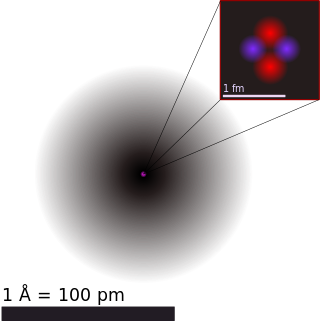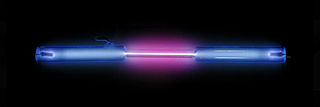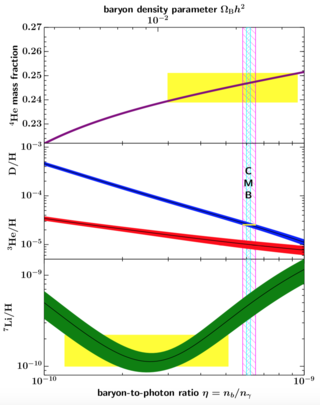
In astronomy and cosmology, baryonic dark matter is hypothetical dark matter composed of baryons. Only a small proportion of the dark matter in the universe is likely to be baryonic.

In astronomy and cosmology, baryonic dark matter is hypothetical dark matter composed of baryons. Only a small proportion of the dark matter in the universe is likely to be baryonic.
As "dark matter", baryonic dark matter is undetectable by its emitted radiation, but its presence can be inferred from gravitational effects on visible matter. This form of dark matter is composed of "baryons", heavy subatomic particles such as protons and neutrons and combinations of these, including non-emitting ordinary atoms.
Baryonic dark matter may occur in non-luminous gas or in Massive Astrophysical Compact Halo Objects (MACHOs) – condensed objects such as black holes, neutron stars, white dwarfs, very faint stars, or non-luminous objects like planets and brown dwarfs.
The total amount of baryonic dark matter can be inferred from models of Big Bang nucleosynthesis, and observations of the cosmic microwave background. Both indicate that the amount of baryonic dark matter is much smaller than the total amount of dark matter.
From the perspective of Big Bang nucleosynthesis, a larger amount of ordinary (baryonic) matter implies a denser early universe, more efficient conversion of matter to helium-4, and less unburned deuterium remaining. If all of the dark matter in the universe were baryonic, then there would be much less deuterium in the universe than is observed. This could be resolved if more deuterium were somehow generated, but large efforts in the 1970s failed to identify plausible mechanisms for this to occur. For instance, MACHOs, which include, for example, brown dwarfs (bodies of hydrogen and helium with masses less than 0.08 M☉ or 1.6×1029 kg), never begin nuclear fusion of hydrogen, but they do burn deuterium. Other possibilities that were examined include "Jupiters", which are similar to brown dwarfs but have masses 0.001 M☉ (2×1027 kg) and do not burn anything, and white dwarfs. [1] [2] [ clarification needed ]

The Big Bang event is a physical theory that describes how the universe expanded from an initial state of high density and temperature. Various cosmological models of the Big Bang explain the evolution of the observable universe from the earliest known periods through its subsequent large-scale form. These models offer a comprehensive explanation for a broad range of observed phenomena, including the abundance of light elements, the cosmic microwave background (CMB) radiation, and large-scale structure. The overall uniformity of the Universe, known as the flatness problem, is explained through cosmic inflation: a sudden and very rapid expansion of space during the earliest moments. However, physics currently lacks a widely accepted theory of quantum gravity that can successfully model the earliest conditions of the Big Bang.

Physical cosmology is a branch of cosmology concerned with the study of cosmological models. A cosmological model, or simply cosmology, provides a description of the largest-scale structures and dynamics of the universe and allows study of fundamental questions about its origin, structure, evolution, and ultimate fate. Cosmology as a science originated with the Copernican principle, which implies that celestial bodies obey identical physical laws to those on Earth, and Newtonian mechanics, which first allowed those physical laws to be understood.

Dark matter is a hypothetical form of matter thought to account for approximately 85% of the matter in the universe. Dark matter is called "dark" because it does not appear to interact with the electromagnetic field, which means it does not absorb, reflect, or emit electromagnetic radiation and is, therefore, difficult to detect. Various astrophysical observations – including gravitational effects which cannot be explained by currently accepted theories of gravity unless more matter is present than can be seen – imply dark matter's presence. For this reason, most experts think that dark matter is abundant in the universe and has had a strong influence on its structure and evolution.
In physical cosmology, Big Bang nucleosynthesis is the production of nuclei other than those of the lightest isotope of hydrogen during the early phases of the Universe. Primordial nucleosynthesis is believed by most cosmologists to have taken place in the interval from roughly 10 seconds to 20 minutes after the Big Bang, and is calculated to be responsible for the formation of most of the universe's helium as the isotope helium-4 (4He), along with small amounts of the hydrogen isotope deuterium, the helium isotope helium-3 (3He), and a very small amount of the lithium isotope lithium-7 (7Li). In addition to these stable nuclei, two unstable or radioactive isotopes were also produced: the heavy hydrogen isotope tritium ; and the beryllium isotope beryllium-7 (7Be); but these unstable isotopes later decayed into 3He and 7Li, respectively, as above.

A black dwarf is a theoretical stellar remnant, specifically a white dwarf that has cooled sufficiently to no longer emit significant heat or light. Because the time required for a white dwarf to reach this state is calculated to be longer than the current age of the universe, no black dwarfs are expected to exist in the universe at the present time. The temperature of the coolest white dwarfs is one observational limit on the universe's age.
A massive astrophysical compact halo object (MACHO) is a kind of astronomical body that might explain the apparent presence of dark matter in galaxy halos. A MACHO is a body that emits little or no radiation and drifts through interstellar space unassociated with any planetary system. Since MACHOs are not luminous, they are hard to detect. MACHO candidates include black holes or neutron stars as well as brown dwarfs and unassociated planets. White dwarfs and very faint red dwarfs have also been proposed as candidate MACHOs. The term was coined by astrophysicist Kim Griest.
A non-standard cosmology is any physical cosmological model of the universe that was, or still is, proposed as an alternative to the then-current standard model of cosmology. The term non-standard is applied to any theory that does not conform to the scientific consensus. Because the term depends on the prevailing consensus, the meaning of the term changes over time. For example, hot dark matter would not have been considered non-standard in 1990, but would be in 2010. Conversely, a non-zero cosmological constant resulting in an accelerating universe would have been considered non-standard in 1990, but is part of the standard cosmology in 2010.
In the fields of Big Bang theory and cosmology, reionization is the process that caused matter in the universe to reionize after the lapse of the "dark ages".

Helium-4 is a stable isotope of the element helium. It is by far the more abundant of the two naturally occurring isotopes of helium, making up about 99.99986% of the helium on Earth. Its nucleus is identical to an alpha particle, and consists of two protons and two neutrons.
In physical cosmology, structure formation is the formation of galaxies, galaxy clusters and larger structures from small early density fluctuations. The universe, as is now known from observations of the cosmic microwave background radiation, began in a hot, dense, nearly uniform state approximately 13.8 billion years ago. However, looking at the night sky today, structures on all scales can be seen, from stars and planets to galaxies. On even larger scales, galaxy clusters and sheet-like structures of galaxies are separated by enormous voids containing few galaxies. Structure formation attempts to model how these structures were formed by gravitational instability of small early ripples in spacetime density or another emergence.
Cosmic ray spallation, also known as the x-process, is a set of naturally occurring nuclear reactions causing nucleosynthesis; it refers to the formation of chemical elements from the impact of cosmic rays on an object. Cosmic rays are highly energetic charged particles from beyond Earth, ranging from protons, alpha particles, and nuclei of many heavier elements. About 1% of cosmic rays also consist of free electrons.
In astronomy, the intracluster medium (ICM) is the superheated plasma that permeates a galaxy cluster. The gas consists mainly of ionized hydrogen and helium and accounts for most of the baryonic material in galaxy clusters. The ICM is heated to temperatures on the order of 10 to 100 megakelvins, emitting strong X-ray radiation.
A weakless universe is a hypothetical universe that contains no weak interactions, but is otherwise very similar to our own universe.

The Five Ages of the Universe is a popular science book written by Professor Fred Adams and Professor Gregory P. Laughlin about the future of an expanding universe first published in 1999.
Observations suggest that the expansion of the universe will continue forever. The prevailing theory is that the universe will cool as it expands, eventually becoming too cold to sustain life. For this reason, this future scenario once popularly called "Heat Death" is now known as the "Big Chill" or "Big Freeze".
The chronology of the universe describes the history and future of the universe according to Big Bang cosmology.

In classical physics and general chemistry, matter is any substance that has mass and takes up space by having volume. All everyday objects that can be touched are ultimately composed of atoms, which are made up of interacting subatomic particles, and in everyday as well as scientific usage, "matter" generally includes atoms and anything made up of them, and any particles that act as if they have both rest mass and volume. However it does not include massless particles such as photons, or other energy phenomena or waves such as light or heat. Matter exists in various states. These include classical everyday phases such as solid, liquid, and gas – for example water exists as ice, liquid water, and gaseous steam – but other states are possible, including plasma, Bose–Einstein condensates, fermionic condensates, and quark–gluon plasma.
In Big Bang cosmology, neutrino decoupling was the epoch at which neutrinos ceased interacting with other types of matter, and thereby ceased influencing the dynamics of the universe at early times. Prior to decoupling, neutrinos were in thermal equilibrium with protons, neutrons and electrons, which was maintained through the weak interaction. Decoupling occurred approximately at the time when the rate of those weak interactions was slower than the rate of expansion of the universe. Alternatively, it was the time when the time scale for weak interactions became greater than the age of the universe at that time. Neutrino decoupling took place approximately one second after the Big Bang, when the temperature of the universe was approximately 10 billion kelvin, or 1 MeV.
In cosmology, the missing baryon problem is an observed discrepancy between the amount of baryonic matter detected from shortly after the Big Bang and from more recent epochs. Observations of the cosmic microwave background and Big Bang nucleosynthesis studies have set constraints on the abundance of baryons in the early universe, finding that baryonic matter accounts for approximately 4.8% of the energy contents of the Universe. At the same time, a census of baryons in the recent observable universe has found that observed baryonic matter accounts for less than half of that amount. This discrepancy is commonly known as the missing baryon problem. The missing baryon problem is different from the dark matter problem, which is non-baryonic in nature.

In astronomy, the lithium problem or lithium discrepancy refers to the discrepancy between the primordial abundance of lithium as inferred from observations of metal-poor halo stars in our galaxy and the amount that should theoretically exist due to Big Bang nucleosynthesis+WMAP cosmic baryon density predictions of the CMB. Namely, the most widely accepted models of the Big Bang suggest that three times as much primordial lithium, in particular lithium-7, should exist. This contrasts with the observed abundance of isotopes of hydrogen and helium that are consistent with predictions. The discrepancy is highlighted in a so-called "Schramm plot", named in honor of astrophysicist David Schramm, which depicts these primordial abundances as a function of cosmic baryon content from standard BBN predictions.